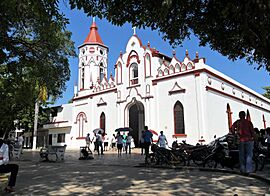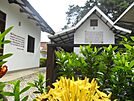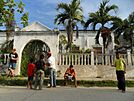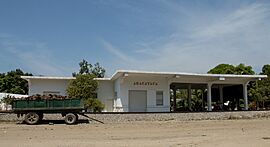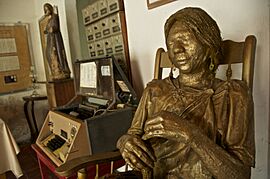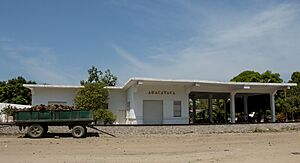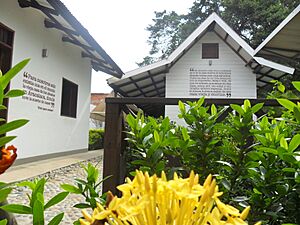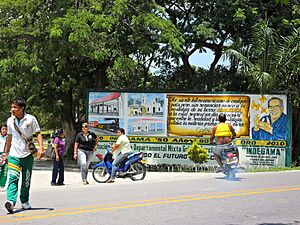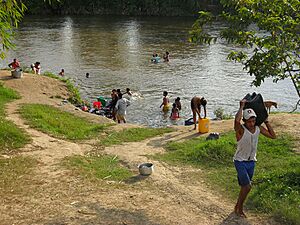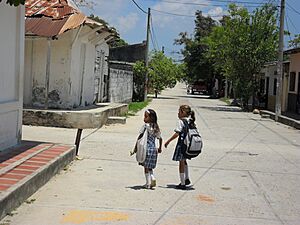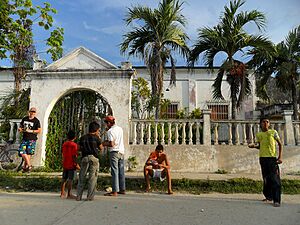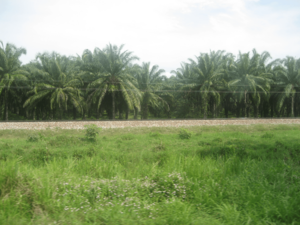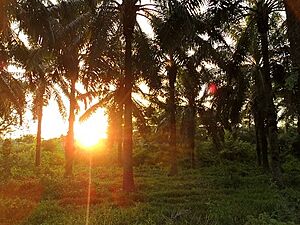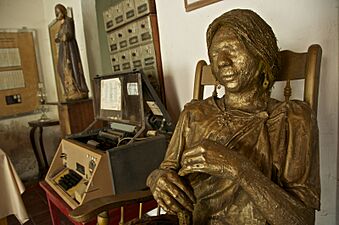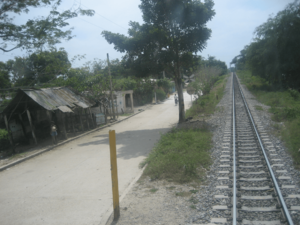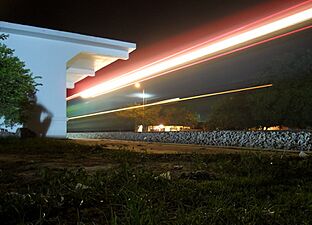Aracataca facts for kids
Quick facts for kids
Aracataca
|
||
|---|---|---|
|
||
| Nickname(s):
Cataca
|
||
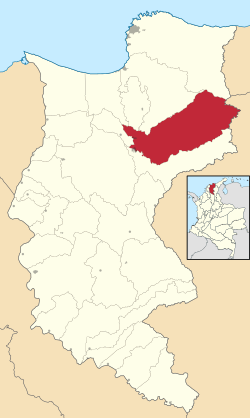
Location of the town and municipality of Aracataca in the Department of Magdalena.
|
||
| Country | Colombia | |
| Region | Caribbean | |
| Department | Magdalena | |
| Foundation | 1885 | |
| Area | ||
| • Total | 1,755 km2 (678 sq mi) | |
| Population
(2020 est.)
|
||
| • Total | 41,872 | |
| Time zone | UTC-5 | |
| Climate | Aw | |
| Website | www.aracataca-magdalena.gov.co |
|
| * | ||
Aracataca (also called Cataca) is a town in Colombia. It's located in the Magdalena Department in the Caribbean part of the country. Aracataca was founded in 1885. It sits next to a small river also named Aracataca. This river flows from the nearby Sierra Nevada de Santa Marta mountains into a large lagoon called the Ciénaga Grande de Santa Marta, which connects to the Caribbean Sea.
Aracataca is about 80 kilometers (50 miles) south of Santa Marta, the capital city of the Magdalena Department. The town is most famous for being the birthplace of Gabriel García Márquez. He was a writer who won the Nobel Prize in Literature.
Contents
Geography and Climate in Aracataca
Aracataca shares its borders with several other towns. To the north are Zona Bananera, Santa Marta, and Cienaga. To the east is the Cesar Department. To the south is Fundación. To the west are El Retén and Pueblo Viejo.
The weather in Aracataca is tropical. This means it is warm and humid all year round.
History of Aracataca
Aracataca was founded in 1885. It officially became its own municipality on April 28, 1915. Before that, it was part of the municipality of Pueblo Viejo. In the late 1800s, large companies, which later joined to form the United Fruit Company, started growing bananas in the area. After many years, the company faced problems and eventually declined. This was partly due to a worldwide economic slowdown and a war.
Aracataca was the inspiration for the fictional town of Macondo in Gabriel García Márquez's famous novel One Hundred Years of Solitude. On June 25, 2006, people in Aracataca voted on whether to rename the town "Aracataca-Macondo." However, not enough people voted, so the name change did not happen.
What Aracataca Produces
Aracataca's economy mainly depends on farming. Farmers grow crops like Oil palm, rice, cotton, sugar cane, beans, plantains, bananas, yuca, and tomatoes. They also raise animals such as cattle, horses, mules, donkeys, chickens, goats, and pigs.
Many people in Aracataca also earn money through informal trade. You can often see many stands selling things like beach towels along the main highway to Santa Marta.
Getting Around Aracataca
You can travel between towns and departments using buses, minivans, and taxis. Many visitors and locals use Berlinas del Fonce, a company with buses leaving the Santa Marta terminal every 30 minutes from 5 AM to 6 PM. A ride costs about $9,000 Colombian pesos per person.
Once you are in Aracataca, you can get almost anywhere using a "ciclotaxi" (a bicycle taxi) for just $1,000 Colombian pesos per person. The rivers in Aracataca are not used for boats. There are also a few small airfields for small planes used for spraying crops.
Highway 45 passes through Aracataca. This highway connects Santa Marta to other towns like Fundación, El Copey, Bosconia, and Curumani, and then goes south towards the Andean part of Colombia. The railway in Aracataca is no longer used for public transportation. It is mostly used to transport coal from the La Loma Calentura region to the Port of Santa Marta.
Famous People from Aracataca
Gabriel García Márquez
Gabriel José de la Concordia García Márquez, often called Gabo or Gabito, was a famous Colombian writer and journalist. He was born on March 6, 1927, in Aracataca. He is considered one of the most important writers of the 20th century, especially in the Spanish language.
García Márquez won the 1972 Neustadt International Prize for Literature and the 1982 Nobel Prize in Literature. Some of his most famous books include “One Hundred Years of Solitude” (1967), which sold over fifty million copies, “Chronicle of a Death Foretold” (1981), and “Love in the Time of Cholera” (1985). He made a writing style called "magic realism" popular. This style mixes magical things with everyday life. García Márquez is the most translated Spanish-language author. When he passed away in April 2014, the president of Colombia called him "the greatest Colombian who ever lived."
Leo Matiz
Leo Matiz (1917–1998) was a Colombian photographer, artist, and journalist. He was born in Aracataca, just like Gabriel García Márquez. Matiz traveled a lot, selling his drawings and illustrations to earn money. In 1951, his art gallery held the first exhibition for the famous Colombian artist Fernando Botero.
Matiz was known for his unique style, including his long hair and colorful jackets. He took pictures of many famous people, such as Frida Kahlo, Diego Rivera, and Louis Armstrong. His photos appeared in well-known magazines like Life and Reader’s Digest. Even after losing an eye due to a robbery, Matiz continued taking photos with an eye patch until he passed away in Bogotá in 1998. The Leo Matiz Foundation was created to keep his work and memory alive.
Antonio Jaramillo
Antonio Jaramillo, known as “El Perro Negro” (The Black Dog), was a Colombian musician and composer. He greatly influenced the folk music of his hometown, Aracataca, especially the "guaracha" style.
- Early Love for Music: Antonio Jaramillo found his passion for music at a very young age. By the time he was four, he was already playing the accordion, which started his lifelong journey in music.
- "The Devil's Accordion": Jaramillo's life was featured in a documentary called “El Acordeón del Diablo” (The Devil's Accordion). This film was about Pacho Rada, another master accordion player from Aracataca. Rada's music deeply touched the people of Colombia.
- A Sad Farewell: When Antonio Jaramillo passed away on March 20, 2012, Aracataca mourned him deeply. His funeral was attended by a huge crowd, filling both the church and the town square. People wore black and cried under the hot sun. Jaramillo's music, similar to Guillermo Buitrago's style, had touched many lives.
Culture in Aracataca
Festivals and Celebrations
People in Aracataca celebrate several traditions throughout the year:
- Three Kings Day: This Roman Catholic holiday is celebrated every year on January 6.
- Carnivals and Holy Week: These celebrations take place between February and March.
- Cultural Week: A week dedicated to local culture.
- Festival of the Unedited Song: A music festival where new songs are presented.
- Municipality's Anniversary: Celebrated in April.
- River Festival: A festival honoring the river.
- Fiestas Patronales: These are large outdoor concerts and semi-bullfights, usually held in July.
Visiting Aracataca: Tourist Spots
Tourism in Aracataca is growing, but it's still a quiet place. The most famous attraction is the house where Gabriel García Márquez grew up. It is now called the Casa Museo (Museum House). Another popular museum is the Casa del Telegrafista. Also, the recently renovated train station will be used to show photographs by Leo Matiz, who was also from Aracataca.
Important Places to See
- Aracataca Train Station: This train station is very important for culture and history. Gabriel García Márquez wrote about it in his novels, and he visited it many times when he was a child. Fans of García Márquez's books often visit the station because it connects them to the places that inspired his stories. Even though it's not a busy train hub anymore, its importance comes from its role in literature and keeping the memory of a great Colombian author alive.
- Plaza de Bolívar: This main town square has a statue of Simón Bolívar. He was a very important leader in the movement for independence in South America. Many towns in Colombia and other Latin American countries have a statue of him. The park has a coffee shop and a playground. It is surrounded by the main church, billiard halls, and stores.
- García Márquez House Museum: Located in Aracataca, this museum honors the life and work of Gabriel García Márquez. The museum is in the author's childhood home, where he spent his early years. He was greatly influenced by the stories, people, and landscapes of this area. Visitors can explore the rooms of the house, which look like they did when García Márquez lived there. The museum shows personal items, photos, writings, and other things related to his life and writing career. It helps visitors understand his childhood and the real-life experiences that inspired his famous books, like "One Hundred Years of Solitude."
- Casa del Telegrafista: The Casa del Telegrafista, or Telegraph Operator's House, is a historic place in Aracataca. This house is important because Gabriel García Márquez spent part of his childhood here. García Márquez often mentioned this house in his books, including "One Hundred Years of Solitude," where it inspired the home of the Buendía family. Today, the Casa del Telegrafista has been fixed up and turned into a museum about García Márquez and his literary work. Visitors can explore the house and learn about his early life, his connections to Aracataca, and what influenced his writing. The museum offers a look into his childhood and the "magic realism" found in his novels. It's a must-see for fans of his work and anyone who loves literature.
- Melquíades Tombstone: In Gabriel García Márquez's "One Hundred Years of Solitude," Melquíades is a mysterious character. He is a traveling gypsy who brings knowledge and magic to the town of Macondo. His presence is felt throughout the story, even after he dies. His writings and inventions continue to affect the characters and events.
Because Melquíades was the first person to die in Macondo, a tombstone was put up for him. This was done to help local people feel more connected to García Márquez's stories and to honor Melquíades as a "great benefactor of Macondo."
Gallery
-
Gabriel García Márquez's Birthplace Museum
-
Billboard of Gabriel García Márquez in Aracataca. The billboard reads: "I feel I am an American from every country, without never renouncing to the nostalgia for my land, to which I returned one day and discovered that between the reality and nostalgia was the Feedstock for my work". - Gabriel García Márquez
-
Oil palm plantations in the municipality of Aracataca
-
African palmtree forest, from which palm oil is being won
See also
 In Spanish: Aracataca para niños
In Spanish: Aracataca para niños


